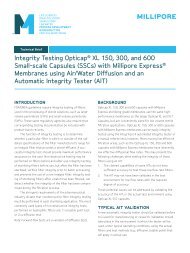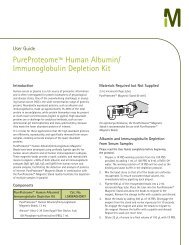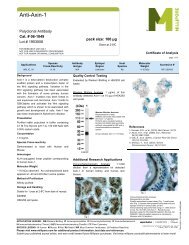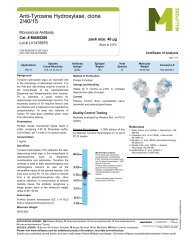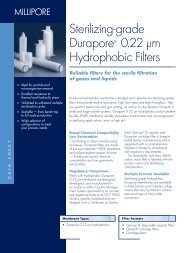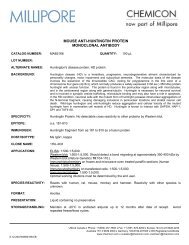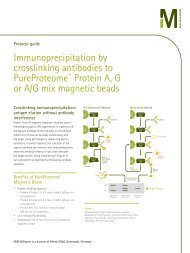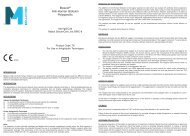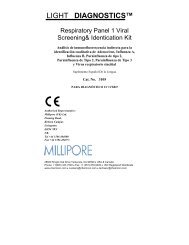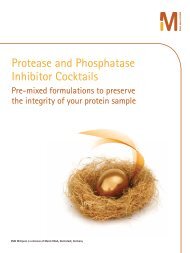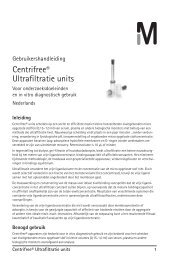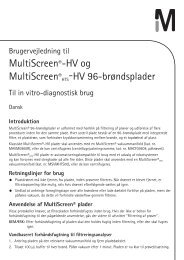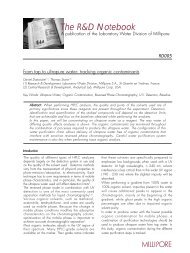Amicon® Ultra-4 Centrifugal Filter Devices - Millipore
Amicon® Ultra-4 Centrifugal Filter Devices - Millipore
Amicon® Ultra-4 Centrifugal Filter Devices - Millipore
You also want an ePaper? Increase the reach of your titles
YUMPU automatically turns print PDFs into web optimized ePapers that Google loves.
User Guide<br />
<strong>Amicon®</strong> <strong>Ultra</strong>-4<br />
<strong>Centrifugal</strong> <strong>Filter</strong> <strong>Devices</strong><br />
for volumes up to 4 mL<br />
<strong>Amicon®</strong> <strong>Ultra</strong>-4 10K device for in vitro diagnostic use<br />
<strong>Amicon®</strong> <strong>Ultra</strong>-4 3K, 30K, 50K, and 100K devices for<br />
research use only; not for use in diagnostic procedures<br />
English<br />
Introduction<br />
<strong>Amicon®</strong> <strong>Ultra</strong>-4 centrifugal filter devices provide fast ultrafiltration, with the capability for high<br />
concentration factors and easy concentrate recovery from dilute and complex sample matrices. The<br />
vertical design and available membrane surface area provide fast sample processing, high sample recovery<br />
(typically greater than 90% of dilute starting solution), and the capability for 80-fold concentration.<br />
Typical processing time is 10 to 40 minutes depending on Nominal Molecular Weight Limit (NMWL). Solute<br />
polarization and subsequent fouling of the membrane are minimized by the vertical design, and a physical<br />
deadstop in the filter device prevents spinning to dryness and potential sample loss. The concentrate is<br />
collected from the filter device sample reservoir using a pipettor, while the ultrafiltrate is collected in the<br />
provided centrifuge tube. The device can be spun in a swinging bucket (for optimal performance) or fixed<br />
angle rotor. <strong>Amicon®</strong> <strong>Ultra</strong>-4 devices are supplied non-sterile and are for single use only.<br />
The <strong>Amicon®</strong> <strong>Ultra</strong>-4 product line includes 5 different cutoffs (Nominal Molecular Weight Limit, NMWL, or<br />
Molecular Weight Cutoff, MWCO):<br />
● <strong>Amicon®</strong> <strong>Ultra</strong> 3K device — 3,000 NMWL<br />
● <strong>Amicon®</strong> <strong>Ultra</strong> 10K device — 10,000 NMWL<br />
● <strong>Amicon®</strong> <strong>Ultra</strong> 30K device — 30,000 NMWL<br />
● <strong>Amicon®</strong> <strong>Ultra</strong> 50K device — 50,000 NMWL<br />
● <strong>Amicon®</strong> <strong>Ultra</strong> 100K device — 100,000 NMWL<br />
<strong>Amicon®</strong> <strong>Ultra</strong>-4 10K filter devices are for in vitro diagnostic use and can be used to<br />
concentrate serum, urine, cerebrospinal fluid, and other body fluids prior to analysis.<br />
<strong>Amicon®</strong> <strong>Ultra</strong>-4 3K, 30K, 50K, and 100K filter devices are for research use only and not for use in<br />
diagnostic procedures.<br />
<strong>Amicon®</strong> <strong>Ultra</strong>-4 <strong>Centrifugal</strong> <strong>Filter</strong> <strong>Devices</strong><br />
1
Applications<br />
● Concentration of biological samples containing antigens, antibodies, enzymes, nucleic acids (DNA/RNA<br />
samples, either single- or double-stranded), microorganisms, column eluates, and purified samples<br />
● Purification of macromolecular components found in tissue culture extracts and cell lysates, removal<br />
of primer, linkers, or molecular labels from a reaction mix, and protein removal prior to HPLC<br />
● Desalting, buffer exchange, or diafiltration<br />
Materials Supplied<br />
The <strong>Amicon®</strong> <strong>Ultra</strong>-4 device is supplied with a cap, a filter device, and a centrifuge tube.<br />
30,000<br />
MWCO<br />
ul<br />
500<br />
250<br />
100<br />
50<br />
4<br />
3<br />
2<br />
Cap<br />
<strong>Filter</strong> device<br />
Centrifuge tube<br />
Required Equipment<br />
● Centrifuge with swinging bucket (preferred) or fixed angle rotor with wells/carriers that can<br />
accommodate 17 mm × 124 mm 15 mL conical-bottomed tubes<br />
CAUTION: To avoid damage to the device during centrifugation, check clearance before spinning.<br />
● Pipettor with 200 microliter (μL) tip for concentrate recovery<br />
Suitability<br />
Preliminary recovery and retention studies are suggested to ensure suitability for intended use. See the<br />
“How to Quantify Recoveries” section.<br />
Device Storage and Shelf Life<br />
Store at 15–30 °C. Shelf life is 3 years from date of manufacture. For cat. nos. UFC801008, UFC801024, and<br />
UFC801096, refer to expiration date on package label.<br />
2 <strong>Amicon®</strong> <strong>Ultra</strong>-4 <strong>Centrifugal</strong> <strong>Filter</strong> <strong>Devices</strong>
Prerinsing<br />
The ultrafiltration membranes in <strong>Amicon®</strong> <strong>Ultra</strong>-4 devices contain trace amounts of glycerine. If this<br />
material interferes with analysis, prerinse the device with buffer or Milli-Q® water. If interference<br />
continues, rinse with 0.1 N NaOH followed by a second spin of buffer or Milli-Q® water.<br />
CAUTION: Do not allow the membrane in <strong>Amicon®</strong> <strong>Ultra</strong> filter devices to dry out once wet. If you are not<br />
using the device immediately after prerinsing, leave fluid on the membrane until the device is<br />
used.<br />
How to Use <strong>Amicon®</strong> <strong>Ultra</strong>-4 <strong>Centrifugal</strong> <strong>Filter</strong> <strong>Devices</strong><br />
1. Add up to 4 mL of sample (3.5 mL if using a 23° fixed angle rotor) to the <strong>Amicon®</strong> <strong>Ultra</strong> filter device.<br />
2. Place capped filter device into centrifuge rotor (swinging bucket preferred); counterbalance with a<br />
similar device.<br />
3. When using a swinging bucket rotor, spin the device at 4,000 × g maximum for approximately<br />
10–40 minutes.<br />
When using a fixed angle rotor, orient the device with the membrane panel facing up.<br />
For <strong>Amicon®</strong> <strong>Ultra</strong> 3K, 10K, 30K, and 50K devices, spin at 7,500 × g maximum for approximately<br />
10–40 minutes.<br />
For <strong>Amicon®</strong> <strong>Ultra</strong> 100K devices, spin at 5,000 × g maximum for approximately 10–20 minutes.<br />
NOTE: Refer to Figures 1 and 2, and Tables 2 and 3 for typical spin times.<br />
4. To recover the concentrated solute, insert a pipettor into the bottom of the filter device and withdraw<br />
the sample using a side-to-side sweeping motion to ensure total recovery. The ultrafiltrate can be<br />
stored in the centrifuge tube.<br />
NOTE: For optimal recovery, remove concentrated sample immediately after centrifugation.<br />
Desalting or Diafiltration<br />
Desalting, buffer exchange, or diafiltration are important methods for removing salts or solvents in<br />
solutions containing biomolecules. The removal of salts or the exchange of buffers can be accomplished<br />
in the <strong>Amicon®</strong> <strong>Ultra</strong>-4 device by concentrating the sample, then reconstituting the concentrate to the<br />
original sample volume with any desired solvent. The process of “washing out” can be repeated until the<br />
concentration of the contaminating microsolute has been sufficiently reduced. See example below.<br />
30,000<br />
MWCO<br />
4<br />
3<br />
2<br />
ul<br />
500<br />
250<br />
100<br />
50<br />
4 mL of<br />
1 mg/mL<br />
protein in<br />
100 mM NaCl<br />
Spin to<br />
concentrate<br />
30,000<br />
MWCO<br />
<strong>Amicon®</strong> <strong>Ultra</strong>-4 <strong>Centrifugal</strong> <strong>Filter</strong> <strong>Devices</strong><br />
ul<br />
500<br />
250<br />
100<br />
50<br />
4<br />
3<br />
2<br />
50 μL of<br />
80 mg/mL<br />
protein in<br />
100 mM NaCl<br />
100 mM<br />
NaCl<br />
Add 3.95 mL of<br />
10 mM NaCl<br />
or exchange<br />
buffer<br />
30,000<br />
MWCO<br />
4<br />
3<br />
2<br />
ul<br />
500<br />
250<br />
100<br />
50<br />
4 mL of<br />
1 mg/mL<br />
protein in<br />
11.1 mM NaCl<br />
Spin to<br />
concentrate<br />
30,000<br />
MWCO<br />
ul<br />
500<br />
250<br />
100<br />
50<br />
4<br />
3<br />
2<br />
50 μL of<br />
80 mg/mL<br />
protein in<br />
11.1 mM NaCl<br />
11.1 mM<br />
NaCl<br />
3
Performance - DNA Concentration<br />
Merck <strong>Millipore</strong> Ltd. has determined that the <strong>Amicon®</strong> <strong>Ultra</strong>-4 30K device provides the best balance<br />
between recovery and spin time for double-stranded DNA for base pairs ranging from 137 to 1,159.<br />
Table 1. Typical Recovery of Nucleotides from <strong>Amicon®</strong> <strong>Ultra</strong>-4 30K Device<br />
Double-stranded<br />
Concentrate<br />
DNA Base Pair Size Spin Time (min) Volume (µL) Recovery (%)<br />
137–1,159 10 50–70 > 85<br />
Spin conditions: Fixed angle rotor, 5,000 × g, room temperature, 2 mL starting volume.<br />
Performance - Protein Concentration<br />
Flow Rate<br />
Factors affecting flow rate include sample concentration, starting vol ume, chemical nature of solute,<br />
relative centrifugal force, centrifuge rotor angle, membrane type, and temperature. Figures 1 and 2,<br />
and Tables 2 and 3 can be used to estimate the time required to achieve a given volume of filtrate or<br />
concentrate for a variety of protein markers. A typical spin time for a 4 mL sample is approximately 10 to<br />
40 minutes (depending on device nominal molecular weight limit). While most of the sample is filtered in<br />
the first 10 to 20 minutes of centrifugation, the lowest concentrate volume (30–75 μL) is reached after<br />
spinning for 20 to 40 minutes.<br />
Figure 1. Typical Filtrate Volume vs. Spin Time (Swinging bucket rotor)<br />
Filtrate Volume (mL)<br />
4.0<br />
3.5<br />
3.0<br />
2.5<br />
2.0<br />
1.5<br />
1.0<br />
0.5<br />
0.0<br />
0 5 10 15 20 25 30 35 40<br />
Spin time (min)<br />
Spin conditions: 4,000 × g, room temperature, 4 mL starting volume.<br />
Protein markers used: Cytochrome c for 3K and 10K, BSA for 30K and 50K, and IgG for 100K, n=6.<br />
4 <strong>Amicon®</strong> <strong>Ultra</strong>-4 <strong>Centrifugal</strong> <strong>Filter</strong> <strong>Devices</strong><br />
3K<br />
10K<br />
30K<br />
50K<br />
100K
Flowrate, continued<br />
Figure 2. Typical Filtrate Volume vs. Spin Time (Fixed angle rotor)<br />
Filtrate Volume (mL)<br />
4.0<br />
3.5<br />
3.0<br />
2.5<br />
2.0<br />
1.5<br />
1.0<br />
0.5<br />
0.0<br />
0 5 10 15 20 25 30 35 40<br />
Spin time (min)<br />
Spin conditions: 7,500 × g for 3K, 10K, 30K, and 50K, 5,000 × g for 100K, room temperature, 4 mL starting<br />
volume. Protein markers used: Cytochrome c for 3K and 10K, BSA for 30K and 50K, and IgG for 100K, n=6.<br />
Table 2. Typical Concentrate Volume vs. Spin Time (Swinging bucket rotor)<br />
Concentrate volume (μL)<br />
Spin time (min) 3K device 10K device 30K device 50K device 100K device<br />
10 1,369 176 73 32 264<br />
15 – 76 46 – 36<br />
20 478 58 37 30 33<br />
25 228 – – – –<br />
30 159 – – – –<br />
40 94 – – – –<br />
Spin conditions: 4,000 × g, room temperature, 4 mL starting volume.<br />
Protein markers used: Cytochrome c for 3K and 10K, BSA for 30K and 50K, and IgG for 100K, n=6 (mean<br />
value of 3 membrane lots). Shaded volumes were used for the calculation of protein recovery in Table 5.<br />
Table 3. Typical Concentrate Volume vs. Spin Time (35° Fixed angle rotor)<br />
Concentrate volume (μL)<br />
Spin time (min) 3K device 10K device 30K device 50K device 100K device<br />
10 613 97 42 23 53<br />
15 – 54 30 – 30<br />
20 170 35 22 15 26<br />
25 118 – – – –<br />
30 92 – – – –<br />
40 62 – – – –<br />
Spin conditions: 7,500 × g for 3K, 10K, 30K, and 50K, 5,000 × g for 100K, room temperature, 4 mL starting<br />
volume. Protein markers used: Cytochrome c for 3K and 10K, BSA for 30K and 50K, and IgG for 100K, n=6<br />
(mean value of 3 membrane lots). Shaded volumes were used for the calculation of protein recovery in Table 5.<br />
<strong>Amicon®</strong> <strong>Ultra</strong>-4 <strong>Centrifugal</strong> <strong>Filter</strong> <strong>Devices</strong><br />
3K<br />
10K<br />
30K<br />
50K<br />
100K<br />
5
Protein Retention and Concentrate Recovery<br />
The membranes used in <strong>Amicon®</strong> <strong>Ultra</strong> devices are characterized by a nominal molecular weight limit<br />
(NMWL); that is, their ability to retain molecules above a specified molecular weight. Solutes with<br />
molecular weights close to the NMWL may be only partially retained. Membrane retention depends on<br />
the solute’s molecular size and shape. For most applications, molecular weight is a convenient parameter<br />
to use in assessing retention characteristics. Merck <strong>Millipore</strong> Ltd. recommends using a membrane with<br />
a NMWL at least two times smaller than the molecular weight of the protein solute that one intends to<br />
concentrate. Refer to Table 4.<br />
Table 4. Typical Retention of Protein Markers<br />
Marker/Concentration<br />
Molecular<br />
Weight<br />
Device<br />
NMWL<br />
% Retention<br />
Swinging Bucket<br />
% Retention<br />
Fixed Angle<br />
Spin Time<br />
(min)<br />
α-Chymotrypsinogen (1 mg/mL) 25,000 3K > 95 > 95 40<br />
Cytochrome c (0.25 mg/mL) 12,400 > 95 > 95 40<br />
Vitamin B-12 (0.2 mg/mL) 1,350 < 35 < 35 40<br />
α-Chymotrypsinogen (1 mg/mL) 25,000 10K > 95 > 95 15<br />
Cytochrome c (0.25 mg/mL) 12,400 > 95 > 95 15<br />
Vitamin B-12 (0.2 mg/mL) 1,350 < 15 < 15 15<br />
BSA (1 mg/mL) 67,000 30K > 95 > 95 10<br />
Ovalbumin (1 mg/mL) 45,000 > 90 > 90 10<br />
Cytochrome c (0.25 mg/mL) 12,400 < 20 < 20 10<br />
Vitamin B-12 (0.2 mg/mL) 1,350 < 10 < 10 10<br />
BSA (1 mg/mL) 67,000 50K > 95 > 95 10 (SB), 5 (FA)<br />
Ovalbumin (1 mg/mL) 45,000 ~ 60 ~ 65 10 (SB), 5 (FA)<br />
Cytochrome c (0.25 mg/mL) 12,400 < 10 < 10 10 (SB), 5 (FA)<br />
Thyroglobulin (0.5 mg/mL) 677,000 100K > 95 > 95 15<br />
IgG (1 mg/mL) 156,000 > 90 > 90 15<br />
Ovalbumin (1 mg/mL) 45,000 < 25 < 20 15<br />
Spin Conditions: Swinging bucket (SB) rotor, 4,000 × g, or 35° fixed angle (FA) rotor, 7,500 × g for 3K, 10K, 30K,<br />
and 50K, 5,000 × g for 100K, 4 mL starting volume, room temperature, n=6 (mean value of 3 membrane lots). The<br />
shaded volumes were taken from Tables 2 and 3.<br />
6 <strong>Amicon®</strong> <strong>Ultra</strong>-4 <strong>Centrifugal</strong> <strong>Filter</strong> <strong>Devices</strong>
Protein Retention and Concentrate Recovery, continued<br />
Factors that determine sample recovery include the nature of the protein solute relative to the device<br />
NMWL chosen, starting concentration, and concentration factor. Table 5 provides typical recoveries for<br />
<strong>Amicon®</strong> <strong>Ultra</strong>-4 devices.<br />
Table 5. Typical Concentrate Recovery<br />
Marker/<br />
Concentration<br />
Cytochrome c<br />
(0.25 mg/mL)<br />
Cytochrome c<br />
(0.25 mg/mL)<br />
Device<br />
NMWL<br />
Spin Time<br />
(min)<br />
Maximizing Sample Recovery<br />
Concentrate<br />
Volume (µL)<br />
Swinging Fixed<br />
Bucket Angle<br />
Low sample recovery in the concentrate may be due to adsorptive losses, over-concentration, or passage of<br />
sample through the membrane.<br />
● Adsorptive losses depend upon solute concentration, its hydrophobic nature, temperature and time<br />
of contact with filter device surfaces, sample composition, and pH. To minimize losses, remove<br />
concentrated samples immediately after centrifugal spin.<br />
● If starting sample concentration is high, monitor the centrifugation process in order to avoid overconcentration<br />
of the sample. Over-concentration can lead to precipitation and potential sample loss.<br />
● If the sample appears to be passing through the membrane, choose a lower NMWL <strong>Amicon®</strong> <strong>Ultra</strong>-4<br />
device.<br />
<strong>Amicon®</strong> <strong>Ultra</strong>-4 <strong>Centrifugal</strong> <strong>Filter</strong> <strong>Devices</strong><br />
Concentration<br />
Factor (x)<br />
Swinging Fixed<br />
Bucket Angle<br />
Concentrate<br />
Recovery (%)<br />
Swinging Fixed<br />
Bucket Angle<br />
3K 40 94 62 43.5 65.0 98.2 96.7<br />
10K 15 76 54 52.3 76.6 97.3 98.5<br />
BSA (1 mg/mL) 30K 10 73 42 56.1 98.6 95.8 95.0<br />
BSA (1 mg/mL) 50K 10 32 23 137.0 177.4 98.8 92.8<br />
IgG (1 mg/mL) 100K<br />
15 (SB),<br />
10 (FA)<br />
36 53 115.9 56.8 92.2 91.3<br />
Spin Conditions: Swinging bucket (SB) rotor, 4,000 × g, or 35° fixed angle (FA) rotor, 7,500 × g for 3K, 10K, 30K,<br />
and 50K, 5,000 × g for 100K, 4 mL starting volume, room temperature, n=6 (mean value of 3 membrane lots). The<br />
shaded volumes were taken from Tables 2 and 3.<br />
7
How to Quantify Recoveries<br />
Calculate total recovery, percent concentrate recovery, and percent filtrate recovery using the method<br />
below. The procedure provides a close approximation of recoveries for solutions having concentrations up<br />
to roughly 20 mg/mL.<br />
NOTE: Appropriate assay techniques include absorption spectrophotometry, radioimmunoassay, refractive<br />
index, and conductivity.<br />
Direct Weighing Procedure<br />
The density of most dilute proteins is nearly equal to the density of water (i.e., 1 g/mL). Using this property,<br />
the concentrate and filtrate volumes can be quantified by weighing them and converting the units from<br />
grams to milliliters. This technique is valid only for solutions with concentrations of approximately<br />
20 mg/mL or less.<br />
1. Before use, separately weigh the empty filter device, the centrifuge tube, and an empty tube for<br />
concentrate collection.<br />
2. Fill filter device with solution and reweigh.<br />
3. Assemble device and centrifuge per instructions.<br />
4. Collect the concentrate with a pipettor and dispense it into the preweighed concentrate collection<br />
tube.<br />
5. Remove the device from the centrifuge tube and weigh the centrifuge tube and concentrate collection<br />
tube.<br />
6. Subtract weight of empty device/tubes to calculate weights of starting material, filtrate, and<br />
concentrate.<br />
7. Assay the starting material, filtrate, and concentrate to determine solute concentration.<br />
8. Calculate recoveries using the weight/volume data and the measured concentrations as follows:<br />
Wc × Cc % concentrate recovery = 100 ×<br />
Wo × Co Wf × Cf % filtrate recovery = 100 ×<br />
Wo × Co % total recovery = % concentrate recovery + % filtrate recovery<br />
W c = total weight of concentrate before assay<br />
W o = weight of original starting material<br />
W f = weight of filtrate<br />
C c = concentrate concentration<br />
C o = original starting material concentration<br />
C f = filtrate concentration<br />
8 <strong>Amicon®</strong> <strong>Ultra</strong>-4 <strong>Centrifugal</strong> <strong>Filter</strong> <strong>Devices</strong>
Specifications<br />
Maximum initial sample volume<br />
Swinging bucket and<br />
fixed angle rotors (45° and 35°)<br />
4.0 mL<br />
Fixed angle rotor (23°) 3.5 mL<br />
Typical final concentrate volume 50–100 μL<br />
Maximum relative centrifugal force<br />
Swinging bucket rotor 4,000 × g<br />
Fixed angle rotor 7,500 × g for 3K, 10K, 30K, and 50K NMWL<br />
Active membrane area 3 cm 2<br />
Dimensions<br />
<strong>Filter</strong> device in tube (capped)<br />
<strong>Filter</strong> device<br />
Materials of Construction<br />
<strong>Amicon®</strong> <strong>Ultra</strong>-4 <strong>Centrifugal</strong> <strong>Filter</strong> <strong>Devices</strong><br />
5,000 x g for 100K NMWL<br />
Length: 124 mm (4.9 in.) Diameter: 17.3 mm (0.7 in.)<br />
Length: 73.4 mm (2.9 in.) Diameter: 17.2 mm (0.7 in.)<br />
<strong>Filter</strong> device Copolymer styrene/butadiene<br />
Membrane <strong>Ultra</strong>cel® low binding regenerated cellulose<br />
Filtrate tube Polypropylene<br />
Filtrate cap and liner Polyethylene<br />
9
Chemical Compatibility<br />
<strong>Amicon®</strong> <strong>Ultra</strong> centrifugal devices are intended for use with biological fluids and aqueous solutions. Before<br />
use, check the sample for chemical compatibility with the device.<br />
Table 5. Chemical Compatibility of <strong>Amicon®</strong> <strong>Ultra</strong> <strong>Filter</strong> <strong>Devices</strong><br />
Acids Concentration Concentration<br />
Acetic acid ≤ 50%* Phosphoric acid ≤ 30%<br />
Formic acid ≤ 5%* Sulfamic acid ≤ 3%<br />
Hydrochloric acid ≤ 1.0 M Sulfuric acid ≤ 3%<br />
Lactic acid ≤ 50% Trichloroacetic acid (TCA) ≤ 10%*<br />
Nitric acid ≤ 10% Trifluoroacetic acid (TFA) ≤ 30%*<br />
Alkalis<br />
Ammonium hydroxide ≤ 10% Sodium hydroxide ≤ 0.5 M<br />
Alcohols<br />
n-Butanol ≤ 70% Isopropanol ≤ 70%<br />
Ethanol ≤ 70% Methanol ≤ 60%<br />
Detergents<br />
Alconox® detergent ≤ 1% Sodium dodecyl sulfate (SDS) ≤ 0.1%<br />
CHAPS detergent ≤ 0.1% Tergazyme® detergent ≤ 1%<br />
Lubrol® PX detergent ≤ 0.1% Triton® X-100 surfactant ≤ 0.1%<br />
Nonidet P-40 surfactant ≤ 2% Tween® 20 surfactant ≤ 0.1%<br />
Sodium deoxycholate ≤ 5%<br />
Organic solvents<br />
Acetone not recommended Ethyl acetate not recommended<br />
Acetonitrile ≤ 20% Formaldehyde ≤ 5%<br />
Benzene not recommended Pyridine not recommended<br />
Carbon tetrachloride not recommended Tetrahydrofuran not recommended<br />
Chloroform not recommended Toluene not recommended<br />
Dimethyl sulfoxide (DMSO) ≤ 5%*<br />
Miscellaneous<br />
Ammonium sulfate Saturated Phenol ≤ 1%<br />
Diethyl pyrocarbonate ≤ 0.2% Phosphate buffer (pH 8.2) ≤ 1 M<br />
Dithiothreitol (DTT) ≤ 0.1 M Polyethylene glycol ≤ 10%<br />
Glycerine ≤ 70% Sodium carbonate ≤ 20%<br />
Guanidine HCl ≤ 6 M Tris buffer (pH 8.2) ≤ 1 M<br />
Imidazole ≤ 100 mM Urea ≤ 8 M<br />
Mercaptoethanol ≤ 0.1 M<br />
* Contact with this chemical may cause materials to leach out of the component parts. Solvent blanks are<br />
recommended to determine whether leachables represent potential assay interferences.<br />
10 <strong>Amicon®</strong> <strong>Ultra</strong>-4 <strong>Centrifugal</strong> <strong>Filter</strong> <strong>Devices</strong>
In Vitro Diagnostic Product Labeling<br />
The following table defines the symbols found on <strong>Amicon®</strong> <strong>Ultra</strong>-4 10K device labels.<br />
Symbol Definition Symbol Definition<br />
V In vitro diagnostic medical device N Date of manufacture<br />
h Catalogue number M Manufacturer<br />
D Do not reuse l Temperature limitation<br />
H Use by d Non-sterile product<br />
g Batch code C<br />
Product Ordering Information<br />
This section lists the catalogue numbers for <strong>Amicon®</strong> <strong>Ultra</strong> <strong>Ultra</strong>filtration <strong>Devices</strong>. See the Technical<br />
Assistance section for contact information. You can purchase these products on-line at<br />
www.millipore.com/products.<br />
Initial<br />
volume<br />
(mL)<br />
Final<br />
concentrate<br />
volume (μL) Product<br />
0.5 15–20 <strong>Amicon®</strong><br />
<strong>Ultra</strong>-0.5<br />
device<br />
<strong>Amicon®</strong> <strong>Ultra</strong>-4 <strong>Centrifugal</strong> <strong>Filter</strong> <strong>Devices</strong><br />
Qty /<br />
pk 3K 10K 30K 50K 100K<br />
8<br />
24<br />
96<br />
500<br />
UFC500308<br />
UFC500324<br />
UFC500396<br />
UFC5003BK<br />
<strong>Amicon®</strong> <strong>Ultra</strong>-0.5 Collection Tubes 96 UFC50VL96<br />
2 15–70 <strong>Amicon®</strong><br />
<strong>Ultra</strong>-2<br />
pre-launch<br />
device<br />
4 50–100 <strong>Amicon®</strong><br />
<strong>Ultra</strong>-4<br />
device<br />
15 150–300 <strong>Amicon®</strong><br />
<strong>Ultra</strong>-15<br />
device<br />
UFC501008<br />
UFC501024<br />
UFC501096<br />
UFC5010BK<br />
UFC503008<br />
UFC503024<br />
UFC503096<br />
UFC5030BK<br />
UFC505008<br />
UFC505024<br />
UFC505096<br />
UFC5050BK<br />
UFC510008<br />
UFC510024<br />
UFC510096<br />
UFC5100BK<br />
24 UFC200324PL UFC201024PL UFC203024PL UFC205024PL UFC210024PL<br />
8<br />
24<br />
96<br />
8<br />
24<br />
96<br />
UFC800308<br />
UFC800324<br />
UFC800396<br />
UFC900308<br />
UFC900324<br />
UFC900396<br />
UFC801008*<br />
UFC801024*<br />
UFC801096*<br />
UFC901008*<br />
UFC901024*<br />
UFC901096*<br />
CE conformity marking<br />
UFC803008<br />
UFC803024<br />
UFC803096<br />
UFC903008<br />
UFC903024<br />
UFC903096<br />
UFC805008<br />
UFC805024<br />
UFC805096<br />
UFC905008<br />
UFC905024<br />
UFC905096<br />
UFC810008<br />
UFC810024<br />
UFC810096<br />
UFC910008<br />
UFC910024<br />
UFC910096<br />
* <strong>Amicon®</strong> <strong>Ultra</strong>-4 and -15 10K devices are for in vitro<br />
diagnostic use. All other devices are for research use only.<br />
11
Notice<br />
The information in this document is subject to change without notice and should not be construed as a<br />
commitment by Merck <strong>Millipore</strong> Ltd. (“<strong>Millipore</strong>”) or an affiliate. Neither Merck <strong>Millipore</strong> Ltd. nor any of its<br />
affiliates assumes responsibility for any errors that may appear in this document.<br />
Technical Assistance<br />
For more information, contact the office nearest you. Up-to-date world-wide contact information is<br />
available on our web site at www.millipore.com/offices. You can also visit the tech service page on our web<br />
site at www.millipore.com/techservice.<br />
Standard Warranty<br />
The applicable warranty for the products listed in this publication may be found at<br />
www.millipore.com/terms (within the “Terms and Conditions of Sale” applicable to your purchase<br />
transaction).<br />
Made in Ireland<br />
Merck <strong>Millipore</strong> Ltd.<br />
Tullagreen,<br />
Carrigtwohill,<br />
Co. Cork, IRL<br />
The M logo is a trademark of Merck KGaA, Darmstadt, Germany.<br />
<strong>Millipore</strong>, Amicon, Milli-Q, and <strong>Ultra</strong>cel are registered trademarks of Merck KGaA.<br />
Alconox and Tergazyme are registered trademarks of Alconox, Inc.<br />
Lubrol is a registered trademark of Imperial Chemical Industries PLC.<br />
Nonidet is a trademark of Royal Dutch/Shell Group.<br />
Triton is a registered trademark of Union Carbide Corp.<br />
Tween is a registered trademark of ICI Americas Inc.<br />
© 2012 EMD <strong>Millipore</strong> Corporation. All rights reserved.<br />
PR03521TR, Rev. A, English, 03/12<br />
12 <strong>Amicon®</strong> <strong>Ultra</strong>-4 <strong>Centrifugal</strong> <strong>Filter</strong> <strong>Devices</strong><br />
C<br />
I<br />
A<br />
M<br />
R<br />
S<br />
D<br />
P<br />
H<br />
D<br />
P<br />
P<br />
M<br />
H<br />
S<br />
C<br />
I<br />
P<br />
N<br />
T<br />
S


